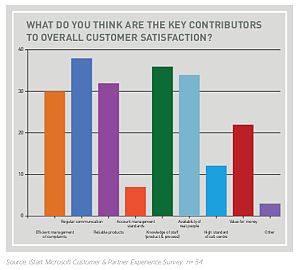Published on the 12/05/2011 | Written by Jonathan Cotton

Almost 80% of business decision makers responsible for customer satisfaction think they deliver ‘poor’ or ‘average’ results…View as PDF
This result is in stark contrast to the almost 100 % that rate customer satisfaction as the number one factor in business success. These were the key findings in a recent iStart-Microsoft survey of business decision makers conducted in late 2010. The survey reflects the responses of 54 senior decision makers responsible for customer satisfaction outcomes. The consensus was that businesses in New Zealand do a very poor job with customer satisfaction, with the majority choosing poor or average to describe the way New Zealand businesses approach customer satisfaction. And whilst 94.4% of business decision makers say that customer satisfaction is the most important thing they can do to drive business growth and success, one in three don’t undertake any customer satisfaction research (38%) to understand whether their customers are happy. Of those factors that contribute to business growth, improving the skills of staff, along with more regular and better targeted communications to customers are cited as the two things businesses could do to increase satisfaction with customers. ‘Latest technology’ and ‘investment’ rated average to low, and ‘risk management’ is perceived to be the least important element out of those listed in the survey relating to business growth and success factors. In presenting the results, Hayden McCall, general manager at iStart, who ran the survey across their readership, noted “there seems to be a disconnect between recognition of what is important, and actually doing something about it. “In this and other surveys it is clear that a customercentric culture driven from the top down delivers results. But there seems to be a lack of customer perspective from leadership, and this leads to the frustration that comes through in the results,” says McCall. Business decision makers also say the number one thing they can do is to really understand the customer and design an approach which shows they are empathetic and have attempted to walk in the customers’ shoes. Sixty nine % of respondents don’t think New Zealand businesses have an adequate focus on customer satisfaction. Regular communications was seen to be the key overall contributor to customer satisfaction (70.4 percent), with staff knowledge (66.7 percent) and having real people available to take calls (63.7 percent), following as second and third most important. Reliable products and efficient management of complaints are seen to be roughly even in terms of importance (below regular communications, staff knowledge and real people), and value for money is seen by 22 percent of respondents as being important to growing customer satisfaction. Regular communications are seen to be the key overall contributor to customer satisfaction (70.4 percent), knowledge of staff (66.7 percent), and having real people available to take calls (63.7 percent). Reliable products and efficient management of complaints are seen to be roughly even in terms of importance. Value for money is seen by 22 percent of respondents as being important. The call centre, account management standards and ‘other’ were seen as the least important factors contributing to customer satisfaction. Face-to-face communication versus customer surveys define the difference between customer service and customer satisfaction according to respondents. When it came to activities that enhanced customer service, the most common answer was face-to-face communication, followed by: Download white paper Satisfaction Flunk Adapt your collections strategy and come out on top… Technical limitations have curbed supply chain ROI but the use of new digital technologies can dramatically improve supply chain performance… Gartner’s top strategic predictions for 2018 and beyond… In a world where your data is considered fair game for marketers, Brian Blau says the virtual personal assistant could give power over information back to the people… The recent flurry of tech listings across the ASX and NZX has created a liquid market for A/NZ business software stocks. In the first of a regular series, Hayden McCall sets out to keep track of their fortunes…[View as PDF]
FURTHER READING

eBook: Seven tips for effectively managing your accounts receivable process in challenging times

Digital technologies fulfil supply chain potential

A top ten peek into the digital future

Power to the people: the rise of virtual personal assistants

ASX/NZX: Tech stock watch




























